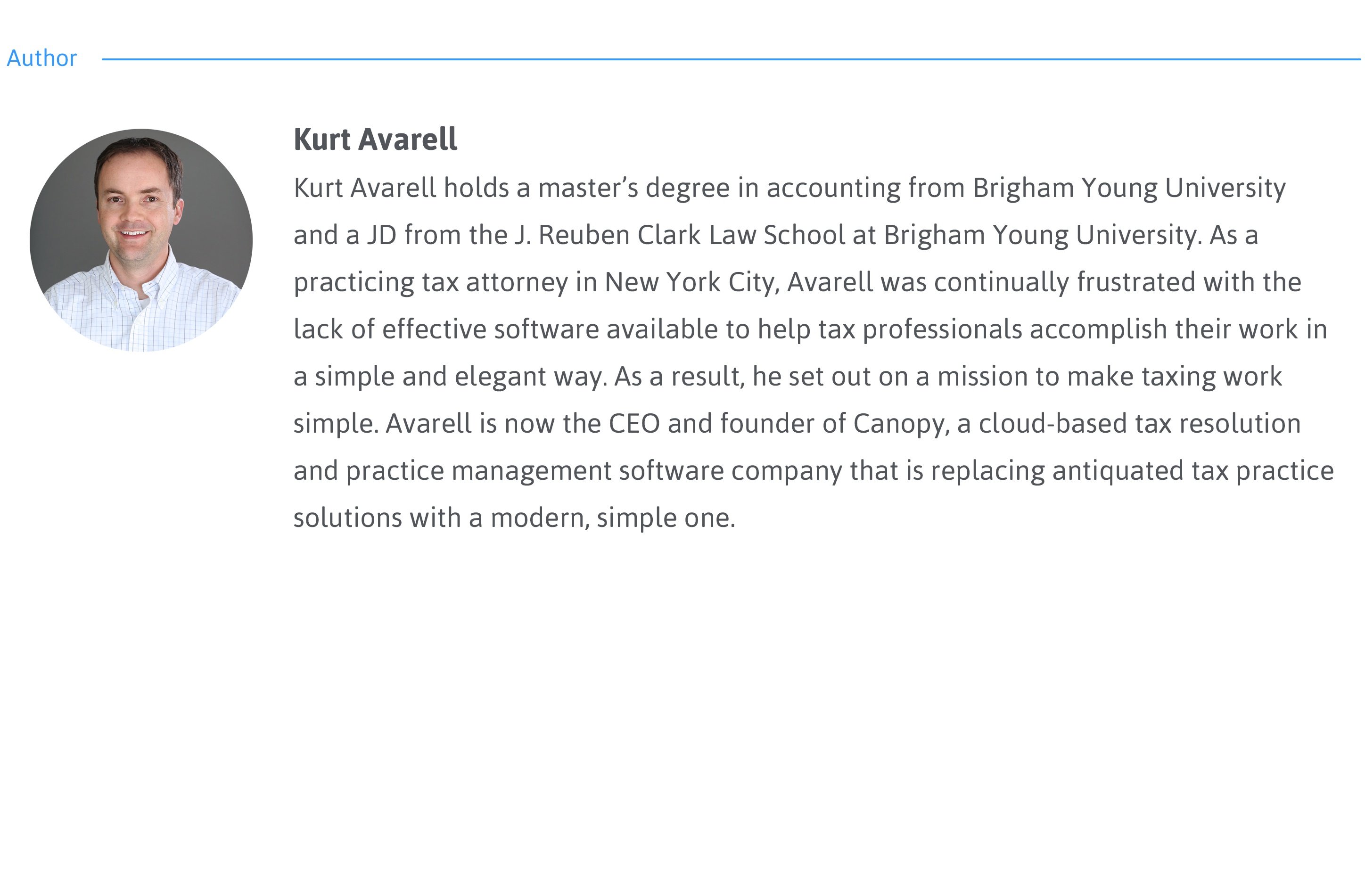Your initial interactions with a tax resolution lead can make all the difference when it comes to converting prospective clients to paying customers. You should have two goals in mind during this conversion process: building trust with your prospective clients and being as efficient as possible.
In this post, I'll share my best practices for lead conversion that I learned while I was a practicing tax professional, including five items you should send to every potential client and three habits that could be costing you clients.
Establishing the Relationship
The first step to converting a lead is to have a kick-off meeting with the prospective client in person or over the phone. This kick-off meeting is designed to build a relationship of trust, which is the basis of any practitioner-client engagement.
After the initial meeting and once a relationship has emerged, it’s time to get to work and make the engagement as efficient as possible. It’s at this point that the transactional aspect of the relationship (i.e., collecting documents, information, etc.) begins.
In my experience, it’s extremely time consuming, for both you and your client, to have to worry about collecting information over the phone or in-person. Instead, use automated workflow to get the information you need more efficiently. This will save you tons of time since it can be done with a single click, and it will also create transparency between you and your prospective client. We'll talk more about the importance of building trust with prospective clients throughout this post.
5 Follow-up Items to Send to Leads ASAP
After you finish your initial conversation with a prospective client, there are several documents you should send them as soon as possible, preferably immediately after the initial meeting. Sending these items quickly shows your prospective client that you are already invested in solving their case and increases their level of commitment to becoming a paying client.
1) Engagement Letter
You should send an engagement letter to every prospective client. This letter is the cornerstone of your legal relationship with the client, and it’s not uncommon to refer back to this agreement several times over the course of an engagement.
For efficiency's sake, use a template letter and fill in your client's information rather than creating a letter from scratch for each new engagement. Ideally, this letter uses an e-signature, which optimizes the amount of time it takes for the client to sign and return the document. Again, the more you can shift your workload to electronic communication and requests, the more efficient you will become.
It’s worth taking a course on how to properly construct engagement letters (look for a post on this soon!). At a minimum, your engagement letters should cover the basics of the engagement, including scope of the services, payment terms, the duration of the agreement, and some language that establishes a baseline for expectations for both you and the client.
2) Payment Agreement
Collecting payment can be one of the most difficult parts of being a service provider, regardless of the type of services being provided. This why I rarely did any tax work unless the client paid some portion of the engagement fee upfront and also let me keep their credit card on file for any future payments (you can read more about online bill pay here).
To get an upfront payment, the customer must trust you -- and all of your actions leading up to sending the invoice should have already set this foundation of trust. Using this system of trust-building and the other tips and tricks I share in this post, my practice had a 99% collection rate. You see, if your customers trust you and your services, they will WANT to pay you. And if your customer wants to pay you, they’ll find a way to pay you, even if they have limited funds. The key is to earn their trust, get paid, and then start working.
Getting paid upfront accomplishes a couple important objectives:
- It ensures you’re working with somebody who can afford to pay you and is serious about their engagement.
- It reduces the amount of time you may spend collecting fees at a later time.
If you’re not already, get set up with an online payment provider. Canopy offers some of these features, but whether Canopy or some other provider, you should be able to collect payments online. I recommend charging a nominal amount for an initial consultation, say, $500, rather than the full fee you charge for your Tax Resolution services, as the smaller fee gives your clients an opportunity to work with you and build trust in your abilities before they pay the full amount. At my practice we found that our conversion rates were much higher once we implemented a smaller fee.
As part of the initial consultation, we contacted the IRS, pulled the customers transcripts (another huge timesaver provided by Canopy), and collected enough information to discover what potential resolutions were available to the client. At the end of the initial consultation, we effectively knew exactly how to solve the client’s case and discussed those options in great detail with the prospective customer.
Because the path forward was clear to us and the prospective client, they were eager to pay the remainder of the fee. Of course, to save everybody time, the terms of the second part of the engagement, including payment details, were included in the original engagement letter, so there should rarely be a need to revise and resign that letter after the initial consultation.
3) Power of Attorney
I generally emailed my prospective clients a Power of Attorney within a few minutes of my first meeting with them. You might ask, why send the Power of Attorney if they’re not a client yet? My answer is that, again, it builds trust. It shows you’re taking action and moving the case forward – and that you care enough that you’re willing to take the time to prepare the Power of Attorney. Of course, if you’re using a software like Canopy, you know how easy it is to prepare a Power of Attorney. In addition, when a prospective client receives an email shortly after talking with you, they'll be less likely to forget about following through with your requests.
After receiving the signed Power of Attorney from the prospective client, I’d suggest not countersigning the Power of Attorney until your client has signed the engagement letter, as discussed above.
4) Account Setup
Continuing on the theme of building confidence, I also recommend sending your prospective client the login information for a client portal, such as the client portal through Canopy, so that they have the ability to start working with you right away—no waiting to schedule a meeting with you.
Canopy allows your client to exchange documents, pay online, view the status of their case, and much more. This allows you to maintain transparency and further build trust with your clients.
5) Survey
Depending on the client’s circumstances, I’d also recommend sending a survey that captures the information you need to get started on their case right away. Ideally, you will send this survey electronically to avoid printing and snail mail (both hallmarks of inefficiency).
If it’s a client who needs help resolving back taxes with the IRS, send a survey like the one Canopy offers for payment plans, offer in compromises, and currently non-collectible status. If it’s a client who needs tax preparation services, send them the client organizer.
3 Habits that Could Lose You Clients
During my career as a tax professional, I identified several practices to avoid when trying to convert a Tax Resolution lead:
Forgetting to get contact information
Always get a prospect's contact information for later follow-up. This is especially easy to forget when somebody calls you for the first time. Even if you're unsure that the person will convert to a paying client in the immediate future, you can still add them to your newsletter or email list so that your practice stays top-of-mind.
Hanging up the phone without giving a call to action
You should never leave a conversation with a Tax Resolution lead with the expectation that they'll contact you when they're interested. Rather, you should leave them with some actionable items that keeps the relationship progressing. As discussed above, send them an Engagement Letter at a minimum.
Failing to follow up
Make sure the first conversation you have with a prospective client is not the last conversation you have with them. Be proactive about follow-up. If you haven’t heard from them in a couple days after sending the Engagement Letter, follow up with a simple email or phone call. Be persistent – you can even set automated follow-ups or reminders to make this process even easier.
Finally, remember to be proactive about sending your prospective client documents and information so that they will feel comfortable reaching out to you with questions. They need a clear path forward, and it’s our responsibility as practitioners to define that path. Do that one simple thing – and watch your conversion rates skyrocket.
Want more tips for automating client follow ups and getting more done? Check out our blog post 8 Simple Ways to Manage Clients Efficiently.












Get Our Latest Updates and News by Subscribing.
Join our email list for offers, and industry leading articles and content.